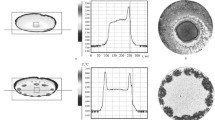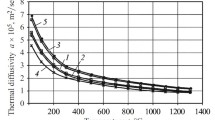Abstract
We present results of theoretical studies of the mechanism for the destruction of heat-resisting composite materials. We study processes caused by the interaction of oxygen atoms and molecules with silicon dioxide and silicon-dioxide-based materials with the inclusion of chemical processes in the intermediate layer between the gas and the composite material surface in rarefied media. We show that the destruction mechanism depends on the catalytic activity controlling the dynamics of various physicochemical processes with the participation of O and O\(_2\) on the surface. We obtain the resulting characteristics of the destruction of glassy materials, which are determined by the action of two mutually converse processes to some extent. We analyze the main regularities of the destruction of glassy materials. We show that the recombination rate depends significantly on the enthalpy of the gas flow stopping. Numerical calculation results show that the process of nonequilibrium mass carryover can be calculated using the engineering approach.
















Similar content being viewed by others
References
N. I. Sidnyaev, “Review of methods for studying hypersonic gas flows past bodies with ablating coating,” Thermophysics and Aeromechanics, 11, 489–508 (2004).
O. E. Gerasimova and S. F. Borisov, “The study of the atomic oxygen recombination on silica by molecular dynamic method [in Russian],” Physical-Chemical Kinetics in Gas Dynamics, 5, 10 pp. (2007).
N. I. Sidnyaev, The Aerodynamics of Hypersonic Flight Vehicles under Surface Degradation Conditions [in Russian], Fizmatlit, Moscow (2017).
N. I. Sidnyaev and E. V. Belkina, “On the influence of hypersonic flow at the speed of a reflow heat-proof surface in terms of destruction [in Russian],” Novye Ogneupory (New Refractories), 1, 20–27 (2020).
V. V. Gorskii and Y. V. Polezhaev, “Heat and mass transfer at the surface of glass-graphite materials in a high-temperature flow of gas,” Fluid Dyn., 7, 931–944 (1972).
N. I. Sidnyaev, “Experimental investigations of mass transfer influence onto aerodynamic performances of solids of rotation with complicated form,” Izvestiya Vuzov. Aviatsionnaya Tekhnika, 2, 25–29 (2005).
N. I. Sidnyaev, “Investigation of aerodynamic characteristics of a hypersonic flow around bodies of revolution with a permeable tip,” J. Appl. Mech. Tech. Phys., 48, 159–165 (2007).
V. V. Gorskii and A. V. Zaprivoda, “Application of the complete thermochemical model of carbon destruction to the problem of destruction of carbon-fiber reinforced plastic material under transient heating,” High Temperature, 52, 230–234 (2014).
A. M. Grishin, A. D. Parashin, and A. S. Yakimov, “Thermochemical destruction of a carbon epoxy composite under multiple pulse loading,” Combustion, Explosion, and Shock Waves, 29, 82–89 (1993).
N. I. Sidnyaev, “Numerical solution of the problem of gas efflux from a closed volume into atmosphere,” Technical Phys. Lett., 31, 9–12 (2005).
A. G. Gofman and A. M. Grishin, “A theoretical study of the thermochemical fracture of graphite in high-enthalpy air flow [in Russian],” PMTF, 4, 107–114 (1984).
R. L. Baker, “Influence of nonequilibrium chemical processes on the sublimation of graphite,” Raketn. Tekh. Kosmonavt., 15, 21–29 (1977).
R. N. Gubta, J. M. Yos, R. A. Thompson, and K.-P. Lee, “A review of reaction rates and thermodynamic and transport properties for an 11-species air model for chemical and thermal nonequilibrium calculations to 30000 K,” in: Technical Report NASA-RP-1232, NASA Langley Research Center, Hampton, Virginia (1990), pp. 6–17.
A. Anna, I. D. Boyd, V. Colombo, E. Ghedini, P. Sanibondi, M. Boselli, and M. Gherardi, “Computational modeling of surface catalysis for graphite exposed to high-enthalpy nitrogen flow,” in: NATO AVT-199/RSM-029 (2012), pp. 5–12.
N. I. Sidnyaev, “Study of heat transfer in the boundary layer in a nitrogen flow past a catalytic graphite wall,” Thermophysics and Aeromechanics, 27, 193–203 (2020).
N. I. Sidnyaev, “Pressure distribution along the surface of combined bodies streamlined by a hypersonic flow,” Tech. Phys. Lett., 32, 564–566 (2006).
N. I. Sidnyaev, “Study of the influence of heat-and-mass transfer on the spherical tip surface on the supersonic flow around a combined body of revolution,” Izvestiya Vuzov. Aviatsionnaya Tekhnika, 2, 32–36 (2006).
N. I. Sidnyaev, “Studies of heat and mass transfer for hypersonic flow past a complex body of revolution,” Thermophys. Aeromech., 13, 17–27 (2006).
Funding
The paper is based on the report given at the International Conference “Mathematical aspects of modern continuum mechanics,” which took place (in an online mode) at the Steklov Mathematical Institute, Russian Academy of Sciences (Moscow, November 8–12, 2021).
Author information
Authors and Affiliations
Corresponding author
Ethics declarations
The author declares no conflicts of interest.
Additional information
Translated from Teoreticheskaya i Matematicheskaya Fizika, 2022, Vol. 213, pp. 555–578 https://doi.org/10.4213/tmf10322.
Rights and permissions
About this article
Cite this article
Sidnyaev, N.I. Accommodation factors and mechanisms for the destruction of carbon- and ceramics-based composite materials. Theor Math Phys 213, 1789–1808 (2022). https://doi.org/10.1134/S004057792212011X
Received:
Revised:
Accepted:
Published:
Issue Date:
DOI: https://doi.org/10.1134/S004057792212011X




